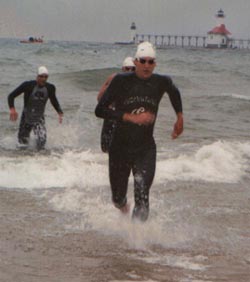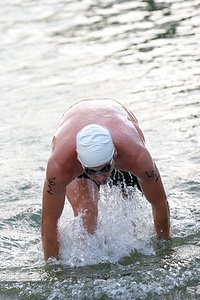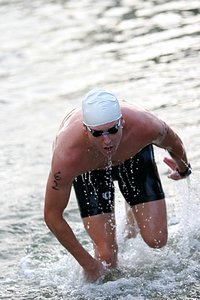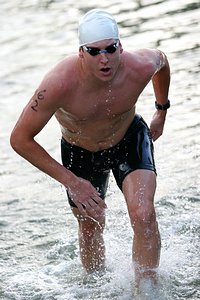Keys to Open Water Swimming Success
If you have ever competed in an open water swimming event, whether it’s the swim leg of a triathlon or just a stand alone swimming event, you learn very quickly that swimming in a large body fo water is night and day from your training in a swimming pool. Every year I put on swim clinics in the weeks leading up to one of the largest sprint races in the area, and every year I see the same thing. People who are strong swimmers in a pool have all kinds of problems in a lake, and some don’t finish. For some, it’s the anxiety and fear associated with the large group of people you start with, for others it’s the muddy water and what might be lurking just a few feet below them (the movie “Jaws” comes up often), and still others it’s the problems they have navigating around the course and all the elements that come into play.
If you have experienced some of these problems before or you have yet to partake in an open water event, here are some tips that will help you succeed. Some of these topics may not apply to your situation depending on what type of water you are swimming in (lake, river, bay, ocean, etc) and you may not be able to take all of this to heart in your first races. As you get better though, you will be able to apply more of these skills to your race, allowing you to focus less on the elements, and more on your performance.
- Scope the course—preferably the day or so before the race, go out to the swim course and watch others swim the course/area. Pay attention to the currents. These are not always obvious from in the water. Watch others swim the course and see if any currents take them to the right or left of straight. If there is no one out in the water, swim some of it yourself, and ask the locals of prevailing currents(especially on the coast). Also keep an eye on the wind, as a strong enough wind will create surface currents. (Watching the direction debris float is also a good indicator). Need another? swim over to the anchored buoys and see if the anchor rope is being pulled in any specific direction. Don’t assume that because you are in a lake that there isn’t any current. Water usually travels towards the dam in man-made lakes and to the creeks and rivers in natural lakes.
- Sighting—the morning of the race line yourself up (usually from the shore) behind the first buoys from the line that you intend to take during the race. Find a landmark (telephone pole, bridge, house, building, etc) that you can sight off of in case you cannot find the buoy when you are swimming in the race. It may be hidden behind a swell or blocked by the glaring sun. Do this with as many buoys as you can on the course. It helps keep you on course in case you lose your bearings with the buoys. (Don’t swim the whole course the morning of the race though). You can also do this in reverse fashion for the finish. Line yourself up looking at the swim finish out at the last buoys, then look around for a large landmark. Usually they have big inflatable objects, etc., but pay attention to which side of the finish they are one. I swam straight for the big float at a race one year and it was set up about 20 yards to the right of the finish. Lost my lead and a lot of time in the process.
- When you lift your head above the water to sight, gravity comes into play, and more times than not, your legs drop down in the water. That’s why head-up swimming can be a disaster and will wear you out in a hurry. Instead of swimming head up freestyle for a number of strokes while you figure it alll out, try this:Lift your head up right before your arm recovers, catch a glimpse, and then turn your head to get your breath like usual as that arm comes around for the recovery. That doesn’t give you much time to sight, but that’s ok. While your head is back down inthe water, think about what your just saw. On the next stroke, lift your head and focus your sighting on the items you saw from the previous sighting. This way the second you lift your head you know what to look for. Again, the sighting itself is very brief, but it allows for very little interuption in your stroke and allows you maintain speed. When I sight I usually look 3-4 times in a row before I go back to regular swimming.
- At the start of the race, which is always a scary moment, try and relax and stay clear of the area where people are jockeying for position. It is not worth the fight to be over 5 feet, or even 5 meters. If you are at the start and the distance to the first buoy is 100 meters, if you move 5 meters to the outside at the start (thereby avoiding the crowd and the fighting) you will only have to swim 100.13 meters, or about 2 feet extra. (Assuming you swim in a straight line!) So it pays to stay to the outside. This is also a great time to swallow your pride. If you are not one of the faster swimmers in your wave, then DO NOT START IN THE FRONT. Unlike running races where people can just run around you as you tire, people in the water may not see you and will swim over top of you. Position yourself conseratively in the group. If you are nervous then move further back. The further from the front you move, the friendlier the swimmers.
-
Be sure to breathe correctly all throughout the swim. sounds simple, but you are really going to have to pay attention to this as there is so much going on around you that everyone tends to take really shallow breaths. Easiest way to do this without thinking too much about it is to make sure you exhale thoroughly while your face is in the water. Loss of breath or hyperventillation is the number one reason I have seen people drop out of the race before the first turn buoy.
- Try and latch onto someone’s feet that’s faster than you and let them do the work! Drafting is often discussed on the bike, but not nearly as popular in the water. Like anything, it takes some practice to sit right on someone’s feet but is highly effective once you get the hang of it. One word of warning: try not to touch the person giving you a free ride. The constant tapping of their toes could end with a heel into your forehead! So play nice.
- Current –If there is a current crossing the course, position yourself at the start to take advantage of it. If the current is running left to right, line up to the left of the field, that way the current will take you ON course and not OFF course. If the currents are with you / against you on a course, try and reserve at much energy as possible by staying within a pack or directly behind someone. Faster swimmers will maximize their advantage in a strong current IF they can get away without anyone drafting. Try to avoid swimming off by yourself if you’re in a current against you. With the current aiding you, maximize the benefit. The faster current will be below the surface, so be sure to pull deep.

Even Lake Swims Can Get Rough
- Waves – Really only a real factor in ocean swimming (although larger lakes can create quite a chop), waves can wreak havoc on your ability to stay on course. This is a great time to be able to bilateral breathe well. Turning your head into a wave won’t give you much chance at air, so breathe away from the waves. In terms of sighting, you will need to do all of your sighting at the top of the wave. Lifting your head up in the trough or bottom of the wave won’t do any good as all you will see is water. It make take a few tries to locate a buoy in these conditions because it the bouy may be behind a wave at the time you are sighting. Be patient. This is also a great time to have some landmarks to sight off of as mentioned above.
- Wetsuits – I won’t go into great detail here as wetsuits command their own article, but wetsuits can be a great aid to your swim. They keep you warm in colder water are extremely buoyant, which makes swimming a little easier and your confidence go up because the added padding softens any blows and you will know that you can’t sink.
- At the finish of the swim, swim up as close as possible to the shore. Don’t stand up to run until you are almost hitting the ground with your chest. If you stand up as soon as you can touch the ground with your hand you will be in water above your knees, which makes it nearly impossible to run. It’s a very simple trick that will move you past people in a hurry and allow you to spend much less energy.




While mastering all of these will certainly take some time, picking up a few of these on race day will make your swim go a little easier and you day more enjoyable.
